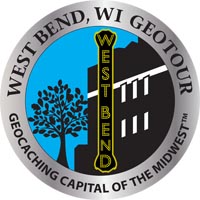UPDATE FOR CACHE BA$H WEEKEND: Due to excessive rainfall, the boardwalk area is flooded. If it's too wet to get to the ammo box, I placed a temporary camo container at the base of the large entrance sign for Albecker Park.
 This geocache is part of the West Bend GeoTour:
This geocache is part of the West Bend GeoTour:
Twenty geocaches have been hidden throughout our historic city that highlight the best of West Bend in any season!
To earn a geocoin, teams must pick up a West Bend GeoTour Passport from the Chamber of Commerce (preferred method) or download a passport. Collect 25 points as detailed in the passport. Link to Updated Passport: West Bend GeoTour Passport.
Remember to record the password from this cache in your GeoTour Passport!
GeoTour Stop #17: An Electric First
Welcome to Albecker Natural Park, one of West Bend's many parks. An aged boardwalk meanders through 90 acres of picturesque wetlands. There is also a historic marker placed here about rural power lines.
The first rural electric power line in the United States was built in 1919 by the West Bend Heating and Lighting Company which was founded by Adam Kuehlthau. It was 24 miles long and served 57 farmers in the townships of West Bend, Barton, Addison, and Wayne. A monthly charge was determined by the number of lights that were in the home. West Bend was ahead of the times.
Before the 1880s, no one had access to electrical power. The nation's first commercial electric plant began operation in Appleton, Wisconsin, in 1882. But very few Wisconsin farms had electricity. Constructing power lines and generating the energy that flowed over them were costly investments that few farmers could afford. Power companies were reluctant to subsidize rural electrification because it was more profitable to provide service to cities. Even as late as 1930, only 1 in 6 farms had electrical service.
Waiting for commercial electric companies to provide services was a too expensive and inefficient solution. So, in 1935, President Franklin Roosevelt established the Rural Electrification Administration (REA) to help farmers meet the growing need for power. The government began to encourage and to grant preference to non-profit, cooperative organizations of farmers to develop their electrical transmission infrastructure. In 1937, Wisconsin's first cooperative, Richland Electric Cooperative, went into service. Within fifteen years, 90% of American farms had electricity. Today, more than 34 million people are served by rural electric systems in the United States, including more than 520,000 in Wisconsin alone.
The Geocache: The cache is a medium sized jar with room for small swag items.